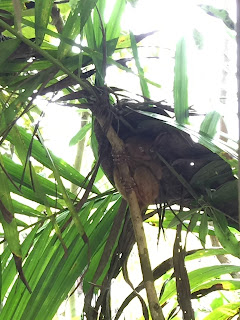Guess where's our first stop in our island hopping in Bohol during our family getaway...
Yes, these kids finally met the famous, Philippine Tarsier!

The Philippine tarsier, (Tarsius syrichta or Carlito syrichta) is very peculiar small animal. In fact it is one of the smallest known primates, no larger than a adult men's hand. Mostly active at night, it lives on a diet of insects. Folk traditions sometimes has it that tarsiers eat charcoal, but actually they retrieve the insects from (sometimes burned) wood. It can be found in the islands of Samar, Leyte, Bohol, and Mindanao in the Philippines.
If no action is taken, the tarsier might not survive. Although it is a protected species, and the practice of catching them and then selling them as stuffed tarsiers to tourists has stopped, the species is still threatened by the destruction of his natural forest habitat. Many years of both legal and illegal logging and slash-and-burn agriculture have greatly reduced these forests, and reduced the tarsier population to a dangerously small size. If no action is taken now, the Philippine tarsier can soon be added to the list of extinct species.
SOURCE.
The animal can also leap even up to 10 feet and agilely maneuver itself from tree to tree. This ability may be due to the fact that they have extra-long tarsal bones which form their ankles and enable them to leap so high. The tarsiers name was derived from the word ‘tarsal’.
Tarsiers are nocturnal creatures, like the owls – sleeping during daytime yet very active at night. They hide in hollows close to the ground; hunts and feeds mainly on fruits and insects such as cockroaches, crickets, and sometimes small lizards. Local folks believe they eat charcoal but in fact they only get the maggots or insects inside burnt wood or to get some salt.
This particular animal’s cry is a loud piercing single note. When they gather, they have a chirping, locust-like sound, and when contented emits a soft sweet birdlike twill. They live in groups, more than just one male and female.
SOURCE.
Definitely one of the interesting places the kids found in Bohol. ♥♥♥





0 Response to "Family Getaway for 2017 Summer: The Philippine Tarsier in Bohol"
Post a Comment